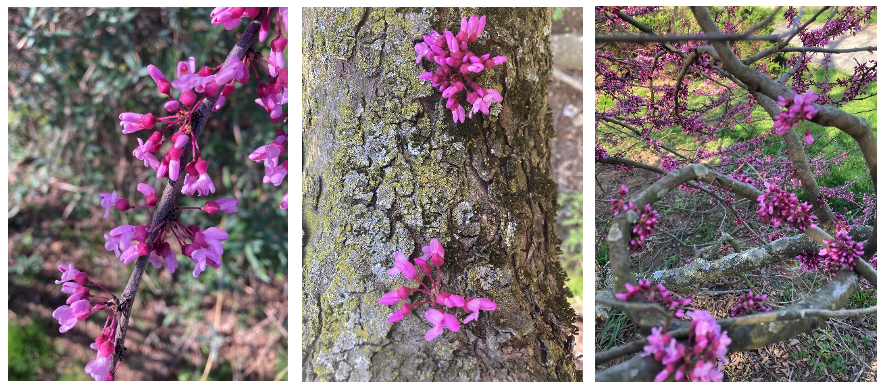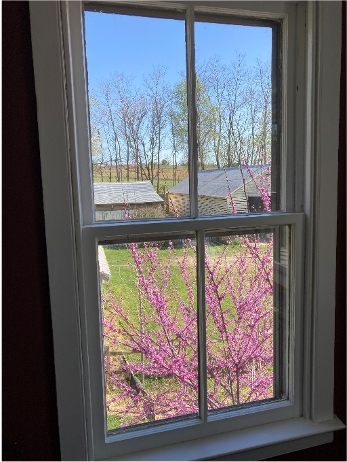Eastern redbud / Cercis canadensis L. / Alexandra Towns
Eastern redbud
Cercis canadensis L.
Alexandra Towns
Eastern redbud: a botanical bridge into the native plant world
Growing up in rural landscapes of the East Coast of the United States, eastern redbud (Cercis canadensis L.) was one of the first native tree species that I learned to identify. Up until this fateful encounter, I was predominantly captivated by plants that were more at my eye level; my earliest wild plant memories are with non-native weedy species such as buttercup (Ranunculus bulbosus L). and Queen Anne’s Lace (Daucus carota L.). It wasn’t until I was in high school that I recall catching a glimpse of the pinkish-lavender flowers emerging in early spring, and wondering what type of tree it was. Redbud didn’t feel as as bold and conspicuous as the weeds that I once played with as a young girl; it seemed to have a wiser, more reserved nature. Even its heart-shaped leaves, irregular branching, and gnarly twisted bark weren’t really evident to me until I got really close to the tree. Redbud serves as an important botanical bridge for me, a “gateway plant,” into the world of native plants.

Eastern redbud (Cercis canadensis L.) flowers, trunk, and twisty branches. Photos: Alexandra Towns
When I returned to the East Coast in my early thirties, having lived in Africa and Europe for several years, seeing the redbud’s blossoms in the spring made me feel like I was re-connecting with an old friend- a quiet, old-soul kind of friend that was humble and had really great stories to tell. It felt as though I had come full circle, having been focused on West African plants that I studied for my MS and PhD degrees, I hadn’t really thought about redbuds for years. When I began to settle into my new home, a redbud was the first tree that I planted in my yard.
What I didn’t realize as a teenager was that the eastern redbud does not exclusively call the East Coast home, nor was my interest in it in any way unique. It is a species of least conservation concern according to the IUCN Redlist. Eastern redbud has a natural range from the state of Texas in the southwest of the United States to the province of Ontario in Eastern Canada. It has several related species that reach further in all directions, even around the globe. It is a deciduous understory tree and can grow as tall as 20-30 feet tall, although it often remains smaller and can take on a shrub-like shape. As the tree matures, flowers also grow directly out of the trunk.
Humans have had a multifaceted relationship with eastern redbud for a long time. From the use of the bark by the Alabama tribe for fever and congestion, the use of its bark for cough and blossoms for food by the Cherokees to the use of the wood by the Havasupai for fence posts and tools, there is broad documentation of Indigenous populations’ uses of the tree. Redbud’s wood does not have commercial value since it does not get particularly large, but it has become a popular landscaping tree and has several cultivars that are highly sought after for their ornamental value.
Redbud also plays several roles in the broader ecosystem. The seeds are consumed by a range of birds including cardinals, quails, and rose-breasted grosbeaks as well as white-tailed deer and gray squirrels. Being one of the first native flowering trees to flower in the spring, it is an important early food source for many native bees; furthermore, the leaves feed the larvae of several butterflies and moths.
 Window view of my eastern redbud (Cercis canadensis L.) announcing the arrival of spring. Photo: Alexandra Towns
Window view of my eastern redbud (Cercis canadensis L.) announcing the arrival of spring. Photo: Alexandra Towns
As I write this reflection, I look out my window and see the redbud tree that I planted once again subtlety announcing the changing of the seasons with its pinkish-lavender blossoms. I also notice that its bark has gotten a little more twisted and knotted since last year. I am grateful to the eastern redbud for initially opening my eyes to native plants and for continuing to remind me to stay connected to my local surroundings.
Literature
Dickson, James G.1990. "Cercis canadensis L. Eastern redbud." Silvics of North America 2: 266-269.
Eastern Redbud, Cercis canadensis. Wisconsin Horticulture Division of Extension. 7 April 2023. https://hort.extension.wisc.edu/articles/eastern-redbud-cercis-canadensis/.
Moerman, Daniel. 2004. Native American Ethnobotany Database. Electronic document, http://naeb.brit.org/.
USDA, NRCS. 2023. The PLANTS Database (http://plants.usda.gov, 04/07/2023). National Plant Data Team, Greensboro, NC USA.
IUCN SSC Global Tree Specialist Group & Botanic Gardens Conservation International (BGCI). 2020. Cercis canadensis. The IUCN Red List of Threatened Species 2020: e.T33892A155693644. https://dx.doi.org/10.2305/IUCN.UK.2020-1.RLTS.T33892A155693644.en. Accessed on 12 April 2023.
About the author
Alexandra is a Research Advisor for international development and an adjunct professor at Towson University, where she teaches a course on ethnobotany. She has carried out assessments related to indigenous foods in Malawi, Zambia, Niger, Uganda, and Madagascar to help incorporate local foods into food security programming. Alexandra holds a PhD in Ethnobotany from Leiden University in the Netherlands. Her research has been based in West Africa studying medicinal plant markets, African plant-based medicine for women and children, and the role of wild foods in food security in Niger. She is currently a council member of the Society for Economic Botany and an associate editor of the journal Economic Botany.
The Society for Ethnobotany is open to researchers, practitioners, and enthusiasts of ethnobotany and economic botany.
The 2026 SEB Annual Meeting will take place in Montpellier, France, from May 31-June 4th!
If you have an interest in ethnobotany or economic botany you can become a member of the Society for Ethnobotany.
If you are a member of the Society for Ethnobotany and would like to contribute a Favorite Plant please contact Blair Orr, blairorr@ymail.com. (Note: ymail, not gmail.)
